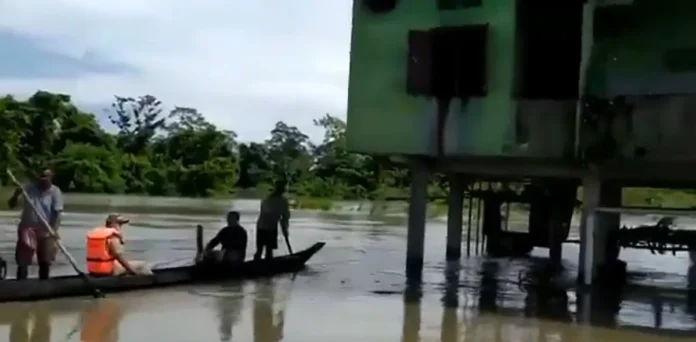Kaziranga National Park, a UNESCO World Heritage Site and one of India’s most iconic wildlife sanctuaries, is grappling with severe flooding due to the rising water levels of the Brahmaputra River. The inundation has not only disrupted the daily operations within the park but has also threatened the safety of its diverse wildlife, including the endangered one-horned rhinoceros, elephants, and numerous other species that call the park home.
The Brahmaputra River, which traverses the northeastern state of Assam, has swollen beyond its banks due to incessant monsoon rains. As a result, large parts of Kaziranga National Park, including many of its wildlife camps, are submerged under water. The floodwaters have affected both the low-lying areas and the higher grounds that are usually considered safe zones for animals during such seasonal inundations.
Kaziranga, which spans approximately 430 square kilometers, is renowned for its rich biodiversity. Every year, it experiences flooding during the monsoon season, which is essential for maintaining the ecological balance of its grasslands and wetlands. However, the intensity and frequency of these floods have increased in recent years, raising concerns about the long-term impact on the park’s ecosystem and its inhabitants.
Park authorities and staff are working around the clock to mitigate the impact of the floods. Rescue operations are underway to relocate stranded animals to higher ground. The Forest Department, along with local volunteers and wildlife NGOs, have set up temporary camps and are providing medical care to injured animals. The use of drones and boats has become crucial in monitoring the flood situation and guiding the rescue teams.
The floods have also posed significant challenges for the park’s infrastructure. Many of the camps and anti-poaching units are either underwater or inaccessible, hampering the efforts to protect the wildlife. Poaching tends to increase during floods as animals move out of the sanctuary in search of dry land, making them vulnerable. To counter this, security has been heightened, and additional patrols have been deployed in and around the park’s periphery.
The local communities living in the vicinity of Kaziranga are also facing hardships due to the floods. Many villages have been evacuated, and the people are taking refuge in relief camps set up by the government. The rising water levels have led to the destruction of crops and property, exacerbating the economic strain on these communities. The government and various NGOs are providing relief materials, including food, water, and medical supplies, to the affected families.
Environmentalists and wildlife experts have expressed grave concerns over the frequent and severe flooding in Kaziranga. They attribute the worsening situation to a combination of factors, including climate change, deforestation, and river management practices. The increasing rainfall intensity due to climate change is causing the Brahmaputra to overflow more frequently. Additionally, the construction of dams and embankments upstream has altered the river’s natural flow, contributing to the flooding downstream.
The floods highlight the urgent need for a comprehensive and sustainable flood management strategy for Kaziranga and the surrounding areas. Experts suggest that measures such as reforestation, better water management practices, and the construction of elevated platforms within the park could help mitigate the impact of future floods. There is also a call for a review of the existing flood management policies to incorporate the latest scientific findings and traditional knowledge of the local communities.
The current situation in Kaziranga underscores the delicate balance between conservation and human intervention. While floods are a natural part of the ecosystem, their increasing severity due to human-induced factors is a cause for concern. It is imperative to strike a balance that ensures the protection of Kaziranga’s unique biodiversity while also safeguarding the livelihoods of the local communities.
In addition, the flooding at Kaziranga National Park due to the rising Brahmaputra River levels is a stark reminder of the challenges posed by climate change and environmental mismanagement. The immediate focus is on rescue and relief efforts, but there is a pressing need for long-term strategies to protect this vital ecological treasure. As the floodwaters eventually recede, the lessons learned from this crisis must inform future actions to ensure the preservation of Kaziranga for generations to come.




